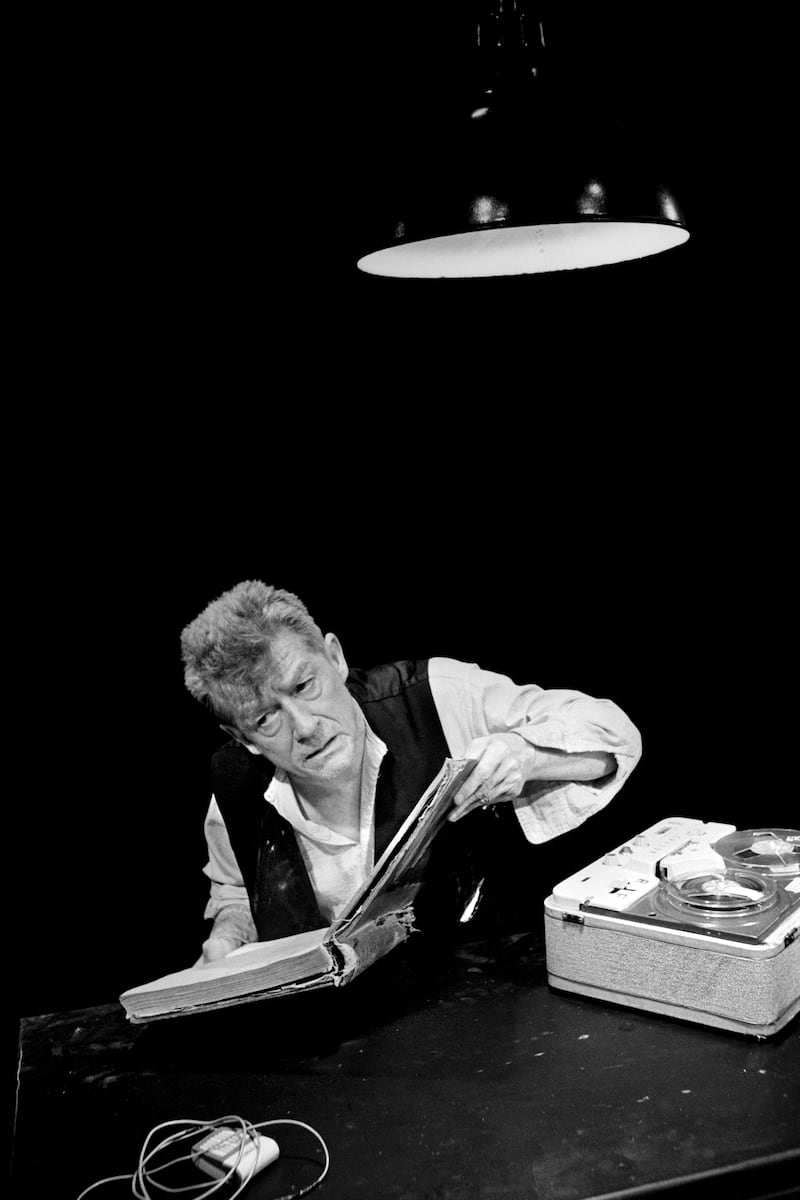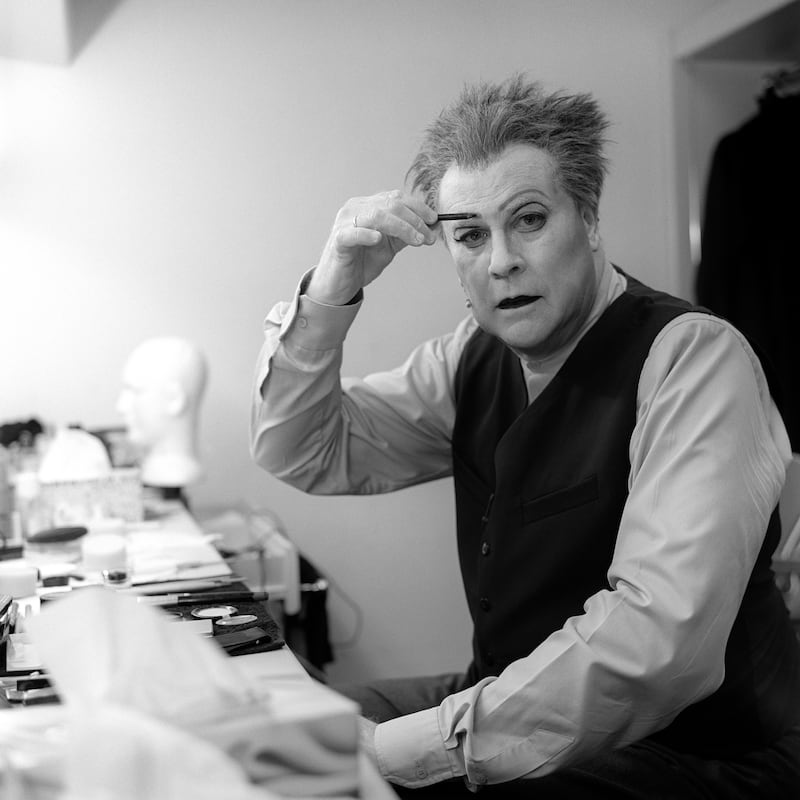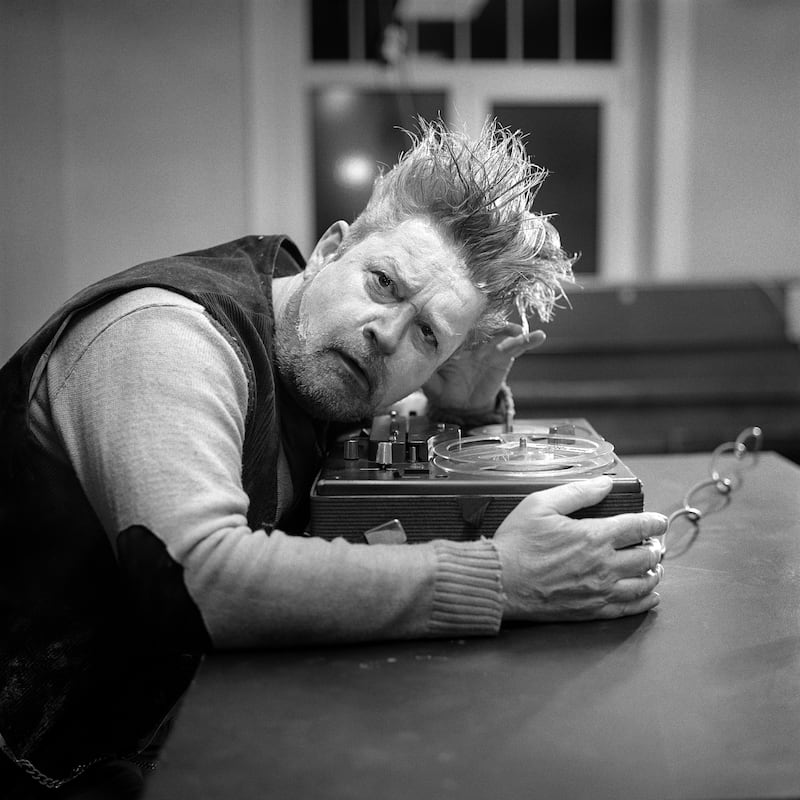“There is no memory in Beckett. Even Krapp’s Last Tape has no memory in the usual sense of associated recall, but rather, a mechanical process set in motion by a jar or vibration: the closing of or opening of a door.” - William S Burroughs, The Adding Machine.
The visual arts played a large part in Samuel Beckett’s life and had a profound effect upon his writing and his philosophy, from the comedy of Buster Keaton and Max Wall through the paintings of his friend Jack Yeats to the photography of Man Ray and Brassaï, whose circles he moved in.
I have photographed numerous productions of Waiting for Godot, Endgame, Happy Days and Krapp’s Last Tape, starring, among others, Peggy Ashcroft, Billie Whitelaw, John Hurt, Michael Gambon, Max Wall, Pierre Chabert, Barry McGovern and Robert Wilson. They all brought their own exuberance to the roles they played.
Krapp’s Last Tape became my favourite to photograph. Beckett’s beautiful one-act play from 1958, set in a dark room, is a stark visual orchestration of light and darkness, movement and silence. Krapp, a 69-year-old man, wanders about the room looking at boxes of prerecorded tapes, finally choosing one, and gently places the tape in the recorder on the table. Above his head a 60-watt light bulb illuminates the action, for Krapp is a writer; the only reality is words. His past self is real for him in the form of words.
Rory McIlroy’s and Tiger Woods’ teams go head to head in TGL
Soft power: the wool entrepreneurs spinning Irish yarns across the globe
Adrian Duncan: ‘I remember praying for a statue not to move because I didn’t want my world to be destroyed’
Julian Benson: ‘I got a call out of the blue in October to say there was a kidney for me’
I remember photographing the wonderful actor Max Wall when he played Krapp at the Riverside Studios, in Hammersmith in London, in 1987, bringing his own brand of music-hall humour, relishing the word spool. “Spoooool,” he croons.
Another essential prop is a banana, which Krapp enjoys. The night I was backstage with Max, he had eaten the banana and the staff were rushing to find a shop open before the show could start. Max had played Vladimir in Waiting for Godot on stage and on television in 1977. Music-hall humour is strewn throughout the world of Samuel Beckett, and the plays benefit in performance from a less reverent attitude than is usually visited upon them.
I always enjoy photographing Krapp’s Last Tape; it’s beautifully contained. I remember seeing Harold Pinter, a good friend of Beckett, playing Krapp in 2006 in homage to his friend and to celebrate the 50th anniversary season of the Royal Court Theatre. Beckett wrote the play for his dear friend Patrick Magee, the Irish actor, after hearing him reading From an Abandoned Work on the BBC Third Programme in 1957, originally called Magee Monologue, performed for the first time at the Royal Court Theatre in 1958.
It became home for much of Beckett’s work through the 1960s and 1970s. Albert Finney performed Krapp there in 1973, barring the author from rehearsals. Beckett’s plays provide the photographer with beautiful lighting, be it Hamm in Endgame asleep in his chair with a blood-stained cloth on top of his head, Nagg or Nell popping out of dustbins, Billie Whitelaw buried up to her neck in mounds of earth, reminiscing about better days, or the activities of two tramps, grunting, scratching, snoozing and quarrelling while waiting beside a tree for someone called Godot. Academics have variously interpreted it as a tragic comedy based on the crucifixion as summarised by St Augustine, a contemporary Everyman, or a Christian play about salvation.

The actor John Hurt was familiar to me in London. John was then living in Ballintubbert House, former home of poet laureate Cecil Day Lewis, located in a valley between the village of Stradbally and the town of Athy, which I know well. John’s first introduction to Beckett was playing Krapp’s Last Tape at the Gate Theatre in Dublin, which received rave reviews and played to full houses. I drove over to London to photograph John performing the role at the Barbican Theatre in 1999.
Waiting with the theatre photographers for John to come on stage, I knew what to expect, having photographed the play countless times. I knew the lighting and the moments that are strong visually. I was standing beside my friend, the doyen of theatre photographers, Douglas H Jeffrey, who I first met when I was an apprentice in the Daily Mail darkroom in 1962.
Douglas supplied Fleet Street’s national newspapers with beautiful black and white photographs of shows in London’s West End. He always wore a beret and an artist’s smock with many pockets to hold film and lenses. Douglas’s archive is with the Theatre Museum, now part of the Victoria and Albert Museum. He had no interest in exhibitions or books about his work, it was just the joy of theatre and black and white printing.

Actor, director and designer Robert Wilson’s powerful production of Krapp’s Last Tape at the Beckett International Festival, Enniskillen, in 2012, was to free Beckett’s work from past preconceptions. I was invited to Robert’s dressing-room to see him being made up for his role as Krapp with white face. On the mirror were black and white postcards of Charlie Chaplin and Buster Keaton. I presented Robert with a copy of my book of photographs of Samuel Beckett.
In 2016, I was invited to the Irish Cultural Centre in Paris as their resident photographer for a month to photograph where Samuel Beckett and James Joyce had lived and to locate their favourite bars. While I was there, the centre was promoting a Samuel Beckett festival. An Israeli drama group were performing Waiting for Godot. The distinguished Irish actor Adrian Dunbar was directing some Beckett shorts. Among the actors was Corkman Denis Conway, who turned up in Skibbereen Parish Hall to perform Krapp’s Last Tape in October 2021. Abbeystrewy did not have all the lighting rails of a West End theatre, but Denis stepped up to the mark and gave a mesmerising performance of the old man listening to his tape-recorded memories echoing through this old Church of Ireland building. Krapp was the perfect vehicle for Conway’s beautiful voice.

Once regarded as obscure dramatic fodder, digestible only by intellectuals, Beckett’s work by the time of his death in 1989 had become so accessible, his plays should have receptive audiences for a long time to come.














